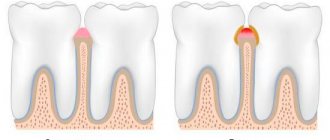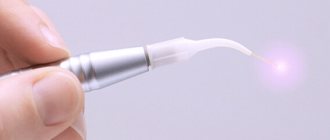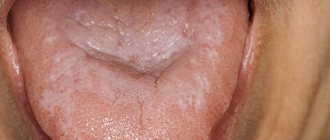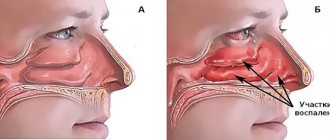The development of dental pathologies, as a rule, is a consequence of the progression of pathological processes occurring inside the human body. Against the background of weakened immunity, the influence of external negative factors increases, which leads to the formation of problem areas. The causes of diseases can be different: by the symptoms manifested on the tongue, lips and gums, as well as by the results of clinical diagnostics, including the use of professional equipment, the source of concern can be determined. Classification of diseases of the oral mucosa helps to make a correct diagnosis and begin therapy in a timely manner, avoiding more serious negative consequences.
Classification of diseases of the oral mucosa
Stomatitis
Stomatitis is an inflammation of the mucous membrane, characteristic of children and adults. Most often, stomatitis is bacterial, viral or fungal in nature. A bad toothbrush with hard, scratchy bristles, poorly fitting braces or crowns, and biting the cheeks and lips can also cause canker sores.
Most often, stomatitis manifests itself in the form of itchy, bright red or whitish sores and erosions on the inner surface of the cheek, tongue or gums. A person may complain of burning and swelling, bad breath, pain when chewing and swallowing. In advanced cases, the temperature may rise, sleep may be disturbed, and the person becomes irritable.
Glossitis
Glossitis is an inflammation of the tongue that can occur either as a result of injury (such as a burn), exposure to pathogens, or as a symptom of certain systemic diseases. Most often, glossitis is manifested by a burning sensation and discomfort in the mouth. The tongue becomes bright red and slightly swollen, and salivation may increase. The patient may complain of loss of taste or changes in the sense of taste, and eating or even just talking causes pain.
Highlit
Haylit (or cheilosis) is a disease in which the lips begin to peel, break, and “sticks” appear in the corners of the mouth. The reasons can be very different: exposure to wind and sun, allergic reaction, chronic diseases with skin lesions (dermatitis, psoriasis, etc.), endocrine pathologies or mycoses.
Oral leukoplakia
Oral leukoplakia is keratinization of the mucous membrane under the influence of aggressive factors, such as smoking. This condition is considered precancerous and therefore requires mandatory treatment.
Most often, oral leukoplakia appears as whitish, grayish, or red plaques that cannot be removed, rough or keratinized areas, or strange thickenings on the lining of the mouth. As a rule, the patient does not experience pain or discomfort, and therefore does not immediately consult a doctor.
Paradontosis
The periodontium is the complex of tissues that surround the tooth and hold it in place: the gums, periodontal ligament, periodontium, root cementum and bone tissue. Periodontal diseases include: gingivitis, periodontitis and periodontal disease.
Gingivitis
Gingivitis is an inflammation of the gums that most often occurs due to inadequate or irregular oral hygiene. Pathogens accumulate in plaque and tartar, causing inflammation.
With gingivitis, inflammation affects only the surface of the gums and may cause bleeding, swelling of the gums, mild pain or discomfort when pressing, and bad breath. If treatment is not started, the inflammation will go further and affect the periodontium.
Periodontitis and periodontal disease
Very often, patients confuse periodontitis and periodontal disease. Periodontitis is an inflammatory disease of periodontal tissues that causes bleeding gums and leads to the gradual exposure of tooth roots, their mobility and, as a result, their loss. Periodontal disease is a non-inflammatory periodontal disease in which the lining of the gums and jaw bone gradually decrease. Unlike periodontitis, in which tooth tissue is destroyed over several years, periodontal disease progresses very slowly and develops over decades. The patient may not even realize that he has gum disease. Periodontal disease is rare compared to other oral diseases.
Home > Therapeutic
dentistry
> Diseases of the oral mucosa > Traumatic lesions of the oral mucosa Traumatic lesions of the oral mucosa
As already mentioned, the oral mucosa has good protective properties, and weak mechanical and physical effects do not have a pronounced effect on it. When exposed to a strong traumatic factor, a response occurs in the form of inflammation. mechanical, chemical and physical injuries
Combined injuries are also distinguished.
Mechanical injury.
This injury can be
acute
, when a violation of the integrity of the mucous membrane occurs due to a one-time strong impact, and
chronic
– when there is prolonged exposure to a weak irritant.
Acute mechanical injury
manifests itself in the form of a hematoma (bruising), erosion or ulcer. With a hematoma, there is pain at the site of injury, which goes away quite quickly, but if the integrity is damaged, painful erosion is formed. If a repeated infection occurs, the wound develops into long-term non-healing ulcers. For hematomas, erosions and small wounds, thorough antiseptic treatment of the damaged area and the entire oral cavity is sufficient. For deep wounds, stitches are applied.
Chronic mechanical
injury is common. Traumatic factors can be: sharp edges of teeth, bridges and removable dentures, tartar, spicy and hot foods, bad habits, etc. Damage to the mucous membrane under the influence of chronic irritants is more often observed in older people.
Changes in the mucous membrane during chronic mechanical trauma may not bother the patient for a long time, but a feeling of discomfort, mild pain, and swelling is often felt. In this case, simultaneously with mechanical trauma, the mucous membrane is exposed to oral microbes, which often leads to inflammation of the injured area.
Elimination of the irritant and ongoing treatment lead to rapid elimination of the lesion. If left untreated, a traumatic ulcer will form, which is also called a decubital ulcer.
.
Traumatic
ulcers can be complicated by fusospirochetosis or candidiasis, and with a long course (2-3 months or more) they can become malignant.
For traumatic
Treatment of ulcers boils down to eliminating the irritant, antiseptic treatment of the ulcer and rinsing the mouth. In case of severe pain of the ulcer, applications with painkillers are indicated. Applications of vitamins A and E, rosehip oil, etc. are prescribed. The oral cavity is thoroughly sanitized.
Chemical damage.
Such damage occurs as a result of exposure of the mucous membrane to chemicals in highly damaging concentrations. For example, some patients, trying to get rid of toothache on their own, apply alcohol, acetylsalicylic acid and other substances to the tooth, and at the same time to the mucous membrane, which often leads to burns.
With such a lesion, sharp pain usually occurs immediately and is localized at the site of contact with the chemical. The clinical picture depends on the nature of the damaging substance, its quantity, and time of action. Either coagulation (acid burn) or liquefaction (alkali burn) necrosis may develop.
Treatment. After a chemical contacts the mucous membrane, it must be removed as quickly as possible. You should immediately begin rinsing your mouth with a weak solution of a neutralizing agent. For an acid burn, this is soapy water, a 0.1% solution of ammonia (15 drops per glass of water), a 2% solution of baking soda (1 teaspoon of baking soda per 2.5 glasses of water). For alkaline - 0.5% solutions of citric and acetic acids (25% teaspoon of acid per glass of water). If there are no neutralizing substances at hand, then rinse thoroughly with water. Thus, it is possible to stop further penetration of the chemical into the tissue.
Further treatment of patients with chemical burns: painkillers, weak antiseptic solutions in the form of mouth baths and rinses, again vitamins A and E, aevit are used. Non-irritating high-calorie pureed food, cold (ice cream), and oral multivitamins are recommended.
Causes of development of diseases of the oral mucosa
- Traumatic damage to oral tissues and other traumatic effects (chemical, thermal, etc.) with the development of traumatic erosion, ulcers, leukoplakia or leukokeratosis (keratinization of the mucous membrane, capable of malignant degeneration).
- Infectious diseases that affect the oral mucosa due to the penetration of viruses, spirochetes, bacteria, and fungi.
Quite often, the occurrence of pathological changes in the oral mucosa is associated with disruption of various organs and systems of the body: allergies, dysfunction of the cardiovascular system, gastrointestinal tract, endocrine disorders, systemic connective tissue diseases, blood diseases and other dermatoses, tuberculosis, AIDS and some other conditions.
Oral diseases in children and their prevention.
The oral mucosa is constantly exposed to a variety of irritants - chemical, mechanical, thermal, numerous microbial agents and toxins. In addition, the oral cavity is a sensitive indicator, showing the state of the internal organs and promptly signaling the presence of problems in one or another body system.
There is a common name for inflammatory diseases of the oral mucosa - stomatitis.
A characteristic manifestation of stomatitis is the appearance on the oral mucosa of foci of redness, blisters, erosions (afts) or ulcers covered with plaque. These lesions are most often detected on the mucous membrane of the cheeks, floor of the mouth, hard palate, and tip of the tongue. Often there is pain at the location of erosions and ulcers, enlargement of nearby lymph nodes, and sometimes an increase in body temperature. The average duration of the disease is 7-14 days. Stomatitis can recur with decreased immunity, poor diet, hypovitaminosis, infectious diseases, and exacerbations are more common in spring and autumn.
Sources of oral infection
Dirty fingers and toes, dirty small objects and parts of toys, candy that has fallen to the ground - all this can end up in a child’s mouth and serve as a source of infection of the oral cavity with pathogenic microorganisms. Therefore, stomatitis is also called “the disease of dirty hands.” Another source of infection is contact with children who already have an oral infection (for example, herpes). Herpetic stomatitis in children has a long incubation period, reaching 26 days, and the first subtle signs of inflammation may escape the attention of the parents of the child, who is already a source of infection for other children. This leads to the rapid spread of viral infection through airborne droplets and contact.
Treatment and prevention of stomatitis
At the first symptoms of stomatitis, you should consult a dentist. In this case, you should not self-medicate. After all, depending on the type of disease, the doctor prescribes specific treatment. Prevention consists, first of all, in strengthening the child’s immunity - maintaining a proper sleep and rest schedule, carrying out water procedures, and a nutritious and balanced diet. Hygiene standards should be observed: clean toys and utensils, do not lick pacifiers and spoons when feeding the baby. Avoid contact with children and adults who have signs of herpes infection. Correctly select, store and change toothbrushes in a timely manner.
The task of parents, from the appearance of the child’s first teeth, medical workers, and kindergarten teachers, is to teach the child to maintain oral and hand hygiene.
Manager
third pediatric department
O.I.Ivanenko
Diagnosis of pathologies
Modern techniques used in dentistry make it possible to quickly identify infectious or fungal diseases of the oral mucosa. It is worth noting that self-diagnosis, as well as subsequent attempts at self-medication, often cause a deterioration in the general condition. Determining the causes of pathological changes is a medical task for which the following are used:
- Microscopic examination of samples.
- Test for allergic reactions.
- Test for viral pathogens.
- General examination and medical history.
Timely diagnosis is necessary to develop and implement the correct treatment plan that addresses both negative symptoms and factors that are proven to cause pathological changes.
Types of pathologies
In accordance with the ICD-10 classification for dentistry, treatment of diseases of the oral mucosa is carried out in four categories. There are inflammatory, infectious, viral and fungal diseases. The treatment plan depends both on the severity of negative symptoms and on the individual characteristics of the patient’s body, which are manifested, among other things, in the reaction to certain groups of medications.
Infectious viral processes
The form of development is directly related to the source of occurrence - thus, the following varieties are characteristic of pathological cycles provoked by a viral infection:
- Catarrhal is a condition characterized by severe swelling and rashes, on the surface of which a gray coating forms.
- Aphthous - damage to the oral mucosa, associated with the formation of painful blisters, leaving behind areas of erosion.
- Ulcerative – similar in symptoms to the first option, but differs in a more pronounced pain syndrome.
Let's consider the main diseases classified as infectious.
Pharyngitis
An inflammatory process affecting the pharynx area, caused both by the introduction of the pneumococcal virus and by systematic inhalation of smoke, polluted or cold air. It is accompanied by discomfort when swallowing, increased sensitivity and a persistent feeling of tickling, as well as general malaise and fever. Diagnosed by visual examination and by examining a smear sample. In difficult cases, it is treated with antibiotics, but in most situations a therapeutic course, including regular inhalations, rinses and compresses, is sufficient.
Glossitis
A disease of the mucous surface of the tongue, leading to a change in its structure and shade. The likelihood of infection increases with the systematic consumption of hot or alcoholic drinks and spicy food, non-compliance with hygiene standards, as well as burns and mechanical damage to tissues. Primary symptoms are characterized by discomfort and a burning sensation. As the pathology develops, areas of redness form, the intensity of salivation increases, and taste perception worsens.
Prolonged absence of medical intervention leads to extensive swelling, which makes it difficult to perform normal functions, as well as to the formation of growths. The drug course of treatment for glossitis involves a special dietary regimen that excludes solid foods from the diet.
Gingivitis
An inflammatory disease of the gum mucosa, most often diagnosed in adolescence, as well as in pregnant patients. Various forms of manifestation determine the presence of an additional classification:
- Ulcerative-necrotic - affects the tissues of the oral cavity, provokes enlargement of the lymph nodes and is characterized by severe pain.
- Catarrhal and atrophic - cause swelling, itching, bleeding, an acute reaction to temperature changes, as well as weakening of the structure.
- Hypertrophic – manifested by a noticeable increase in the size of the gingival papillae, accompanied by bleeding and pain.
The timing of treatment for gingivitis depends on the stage at which the pathology is detected. The dentist’s priority task is to remove plaque and relieve inflammatory processes.
Stomatitis
Infection is introduced in different ways, most often as a result of mechanical damage to tissue. As it develops, characteristic round ulcers are formed, localized on the inside of the lips and cheeks, as well as in the area of the root of the tongue.
When diagnosing, it is recommended to treat the oral mucosa, having previously excluded products containing sodium lauryl sulfate from everyday use, since the active component provokes additional irritation. Anesthetics help relieve pain, and antiseptic and anti-inflammatory compounds are used to remove the film.
Principles of treatment of diseases of the oral mucosa
Basic principles of treatment of diseases of the mucous membranes of the mouth, lips and tongue:
- Rational treatment requires contact between the dentist and other dental and non-dental professionals.
- Treatment must be carried out in compliance with the principles of bioethics, these diseases must be considered from the point of view of the state of the whole organism, therefore in most cases one cannot limit oneself to local effects only.
- An axiom for the dentist should be the elimination of all unfavorable irritating factors in the patient’s oral cavity that can support and provoke the development of the pathological process. The use of so-called cauterizing agents and prolonged use of the same mouth rinses is unacceptable.
- Treatment should begin only after at least one preliminary diagnosis has been established and the following requirements have been met: be comprehensive; provide a pathogenetic approach; do not violate the anatomical and physiological characteristics of the oral mucosa; eliminate the pain factor; promote rapid epithelization of lesions; provide for the active involvement of the patient in performing treatment procedures at home.
Therapy methods
- Etiotropic and pathogenetic therapy aimed at eliminating the cause of the disease (antiviral, antibacterial therapy due to the infectious nature of stomatitis, glossitis, cheilitis, vitamin therapy for hypovitaminosis, treatment of the underlying disease that caused the appearance of a pathological process in the oral cavity) of the mucous membrane;
- Local treatment aimed at eliminating local traumatic factors, the main symptoms of the disease and faster healing of existing erosions and ulcers;
- A general strengthening procedure that stimulates the body's defenses.
Prevention
To prevent painful symptoms, experts recommend following the universal rules of oral hygiene:
- use properly selected toothbrushes, use them systematically, and also avoid bad habits, especially smoking.
- It is recommended to control your diet: in some cases, oral irritation may be caused by excessive consumption of oranges, lemons, etc.
- the habit of cleaning seeds with teeth rather than with hands can become unfavorable for the oral cavity.
Literature
- Banchenko G.V. Combined diseases of the oral mucosa and internal organs. - M.: Medicine, 1979. - 190 p.
- Banchenko G.V., Maksimovsky Yu.M., Grinin V.M. Language is the “mirror” of the body: Clinical guide for doctors. - M., 2000. - 408 p.
- Borovsky E. V., Danilevsky N. F. Atlas of diseases of the oral mucosa. — 2nd ed., revised. and additional - M.: Medicine, 1991. - 320 p.
- Danilevsky N. F., Leontyev V. K., Nesin A. F., Rakhniy Zh. I. Diseases of the oral mucosa. - M., 2001. - 271 p.
- Diagnosis, treatment and prevention of dental diseases / V. I. Yakovleva, E. K. Trofimova, T. P. Davidovich, G. P. Prosveryak. — 2nd ed., revised and supplemented. - Mn.: Higher. school, 1994. - 494 p.
- Dmitrieva L. A., Glybina N. A., Glybina T. A. et al. Experimental substantiation of the use of a new antioxidant drug in the treatment of erosive and ulcerative lesions // Periodontology. — 2012, No. 3 (64). - pp. 52-58.
- Diseases of the mucous membrane of the mouth and lips / Ed. prof. E. V. Borovsky, prof. A. L. Mashkilleyson. - M.: Medicine, 1984. - 400 p.
- Diseases of the oral mucosa: Textbook / Ed. L. M. Lukinykh. - N. Novgorod: Publishing House of NGMI, 1983. - 212 p.
- Karakov K. G., Vlasova T. N., Oganyan A. V., Pisarev G. Yu. Optimization of complex therapy of lichen planus of the oral mucosa // Dentist-practitioner. - 2012, No. 1. - P. 35-37.
- Karakov K. G., Vlasova T. N., Oganyan A. V., Polyakova O. V. The role of complex therapy in the treatment of herpetic infection of the dental system // Practitioner dentist. - 2012, No. 2. - P. 48-49.
- Practical guide to anti-infective chemotherapy / Ed. L. S. Strachunsky, Yu. B. Belousov, S. N. Kozlov. - M.: Borges, 2002. - 384 p.
- Rybakov A. I., Banchenko G. V. Diseases of the oral mucosa. - M.: Medicine, 1978. - 232 p.
- Therapeutic dentistry: textbook: 3 hours / ed. G. M. Barera. - M.: GEOTAR-Media, 2055. - Part 3. - 288 p.
- Tretyakovich A. G., Borisenko L. G., Pishchinsky I. A. Differential diagnosis and principles of treatment of diseases of the oral mucosa: educational method. allowance. — 2nd ed., revised. and additional - Mn.: BSMU, 2005. - 66 p.
- Udzhukhu V. Yu., Minatulaeva M. A., Kubylinsky A. A. Pathogenetic rationale and clinical effectiveness of the use of Lavomax in patients with exudative erythema multiforme // Farmateka. - 2008, No. 9. - P. 60-62.
- Tsepov L. M., Nikolaev A. I. Medical tactics for erosive and ulcerative lesions of the mucous membrane of the mouth, tongue and lips (Training manual). - Smolensk: SGMA, 2005. - 16 p.
Exudative erythema multiforme of the oral cavity
The disease begins suddenly with malaise, chills, weakness, and increased body temperature (in severe cases, up to 38 °C and above). Patients complain of headaches, aching pains throughout the body, pain in muscles and joints, and sore throat. After 1-2 days, bluish-red spots appear on the hands, forearms, legs, and sometimes the face and neck, slightly rising above the surrounding skin. Their central part sinks slightly and takes on a bluish tint, while the peripheral part retains a pinkish-red color (cockades). Subsequently, a subepidermal bubble filled with serous or hemorrhagic contents may appear in the central part. Skin rashes are sometimes accompanied by itching and burning or generally go away without pain.
The mucous membranes of the lips, cheeks, floor of the mouth, tongue, and soft palate are most often affected. The first manifestations of exudative erythema multiforme in the oral cavity are diffuse or limited erythema and swelling of the mucous membrane, against which subepithelial blisters of various sizes appear. Damage to the oral mucosa is accompanied by severe pain even at rest. When moving the tongue and lips, the pain increases sharply, making it difficult to eat. Patients are starving, which further worsens their condition. The blisters open quite quickly, forming painful erosions on the oral mucosa, covered with fibrinous plaque. On the red border of the lips, erosions become covered with bloody crusts, making it difficult to eat and open the mouth. In the first days after the opening of the blisters, along the edges of the erosions one can see grayish-white remnants of the covering of the blisters; when pulled, the epithelium cannot be stratified (negative Nikolsky's sign). Poor oral hygiene and the presence of carious teeth aggravate the course of erythema multiforme. Infection of erosive surfaces with oral microflora occurs. Sometimes the course of exudative erythema multiforme is complicated by the addition of fusospirochetosis. Erosion on the oral mucosa becomes covered with a thick layer of yellowish-gray plaque, plaque appears on the teeth and tongue, and bad breath appears. Salivation increases. Regional lymph nodes are enlarged and painful. The period of exacerbation is 2-4 weeks. Erosion epithelializes after 7-12 days; after healing, no scars remain.
The picture of peripheral blood during the period of exacerbation of exudative erythema multiforme corresponds to an acute inflammatory process.
The severity of the course of exudative erythema multiforme is determined mainly by the nature of the damage to the oral mucosa. The severe form is characterized by a pronounced hyperergic reaction of the body, as well as generalized damage to the mucous membranes of the mouth, eyes, genitals and skin.
In the case of a mild course of exudative erythema multiforme, the general condition of the patients does not change significantly; isolated elements of the lesion are detected on the oral mucosa. However, as the duration of the disease increases, its severity worsens. For exudative erythema multiforme of an infectious-allergic nature, a long, relapsing course is typical. Exacerbations of the disease are observed mainly in the autumn and spring periods (1-2 times a year), although there are known cases of more frequent exacerbations of the disease. Sometimes relapses can be triggered by hypothermia, previous infections and other factors that weaken the body’s resistance. Exudative erythema multiforme lasts for years. During periods between exacerbations, there are no changes in the oral mucosa and skin.
Symptomatic (toxicoallergic) exudative erythema multiforme recurs only when the patient comes into contact with the etiological factor (drug-allergen).
Cytological examination of scrapings from the area of erosion reveals a picture of acute nonspecific inflammation.
Histologically, the subepithelial location of blisters is determined in exudative erythema multiforme. There are no signs of acantholysis. The rejected epithelium undergoes necrosis, swelling and inflammatory infiltration in the underlying connective tissue.









